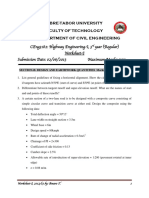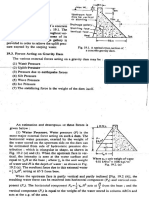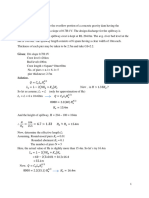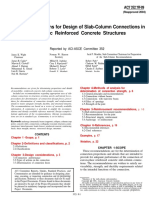0 ratings0% found this document useful (0 votes)
420 views1.5.2 The Seismic Coefficient Method: Earthquake Engineering Dept. of Civil Engg, UVCE
This document summarizes the seismic coefficient method for determining seismic loads on structures. The method uses equivalent static lateral loads that are proportional to the total weight of the structure. The proportion is determined by multiplying various factors like zone, importance, and response reduction. The total base shear is calculated as the product of the seismic coefficient and total weight. This base shear is then distributed up the height of the building based on each floor's weight and height. While simple, the method provides conservative results and cannot account for structural irregularities or higher vibration modes. It is best used for checking designs against moderate earthquakes.
Uploaded by
Vaibhav SengarCopyright
© © All Rights Reserved
Available Formats
Download as PDF, TXT or read online on Scribd
0 ratings0% found this document useful (0 votes)
420 views1.5.2 The Seismic Coefficient Method: Earthquake Engineering Dept. of Civil Engg, UVCE
This document summarizes the seismic coefficient method for determining seismic loads on structures. The method uses equivalent static lateral loads that are proportional to the total weight of the structure. The proportion is determined by multiplying various factors like zone, importance, and response reduction. The total base shear is calculated as the product of the seismic coefficient and total weight. This base shear is then distributed up the height of the building based on each floor's weight and height. While simple, the method provides conservative results and cannot account for structural irregularities or higher vibration modes. It is best used for checking designs against moderate earthquakes.
Uploaded by
Vaibhav SengarCopyright
© © All Rights Reserved
Available Formats
Download as PDF, TXT or read online on Scribd
You are on page 1/ 1
CHAPTER 1
INTRODUCTION
1.5.2 The Seismic Coefficient Method
This is the simplest of the available methods and is applicable to structures, which are
simple, symmetric, and regular. In this method, the seismic load is idealized as a system of
equivalent static loads, which is applied to the structure and an elastic analysis is performed
to ensure that the stresses are within allowable limits. The sum of the equivalent static loads
is proportional to the total weight of the structure and the constant of proportionality, known
as the seismic coefficient, is taken as the product of various factors, which influence the
design and are specified in the codes. Typically, the design horizontal seismic coefficient Ah
is given by
Ah =
----- (1.1)
Where, Z = Zone factor
I = Importance factor
R = Response reduction factor
Sa/g = Response acceleration co-efficient
The total horizontal load, also known as the base shear is then taken as,
Vb = Ah x W
----- (1.2)
Where, W is the total weight of the structure (Dead Load)
The base shear calculated above is then distributed along the height of the building using the
formula, Qi = Vbx Wihi2 / Wihi2
----- (1.3)
Where, Qi is the lateral force at the top of floor i,
Wi is the total of dead and appropriate amount of live load at the top of floor i,
hi is the height measured from the base of the building to the top of floor i.
The seismic coefficient method gives conservative results but has the advantage of being
simple and easy to use. It ignores the effect of higher modes and cannot accommodate
irregularities in the structure. It is used for checking against moderate earthquakes since the
Earthquake Engineering
Dept. of Civil Engg, UVCE
Page 11
You might also like
- İMÜ331 - Soil Mechanics I: Seepage Flow Nets100% (1)İMÜ331 - Soil Mechanics I: Seepage Flow Nets17 pages
- Earthquake Resistant Design of Structures by Pankaj Agarwal PDFNo ratings yetEarthquake Resistant Design of Structures by Pankaj Agarwal PDF536 pages
- CE-441 Foundation Engineering (2010-2016)No ratings yetCE-441 Foundation Engineering (2010-2016)26 pages
- UNIT-2 Slope Deflection Method & Moment Distribution MethodNo ratings yetUNIT-2 Slope Deflection Method & Moment Distribution Method63 pages
- Hydraulics Engineering Lec #1:: Specific Energy and Critical DepthNo ratings yetHydraulics Engineering Lec #1:: Specific Energy and Critical Depth20 pages
- Statically Determinant Structure PDF FreeNo ratings yetStatically Determinant Structure PDF Free21 pages
- A Road Embankment 10 M Wide at The Formation Level 60260bc4adf4ee28005ddae8No ratings yetA Road Embankment 10 M Wide at The Formation Level 60260bc4adf4ee28005ddae83 pages
- Multiple-Choice Test Runge-Kutta 4th Order Method: y X Xy DX Dy100% (1)Multiple-Choice Test Runge-Kutta 4th Order Method: y X Xy DX Dy3 pages
- Base Shear - Uniform Building Code (UBC) : V C Iw/Rt100% (1)Base Shear - Uniform Building Code (UBC) : V C Iw/Rt5 pages
- Hydraulic Jumps in Sloping Channels - ThandaveswaraNo ratings yetHydraulic Jumps in Sloping Channels - Thandaveswara14 pages
- Area Moment of Inertia WRT An Inclined Axis - 202204070730No ratings yetArea Moment of Inertia WRT An Inclined Axis - 20220407073032 pages
- 5 One Dimensional Flow of Water Through SoilsNo ratings yet5 One Dimensional Flow of Water Through Soils28 pages
- This Study Resource Was: Transition CurvesNo ratings yetThis Study Resource Was: Transition Curves7 pages
- A Simply Supported Beam of 4m Effective Span Is Laterally Supported Throughout100% (1)A Simply Supported Beam of 4m Effective Span Is Laterally Supported Throughout1 page
- Introduction To Axially Loaded Compression MembersNo ratings yetIntroduction To Axially Loaded Compression Members21 pages
- CH2 - Flow Through Single Combined PipelinesNo ratings yetCH2 - Flow Through Single Combined Pipelines66 pages
- Numerical Methods and Implementation in Geotechnical Engineering – Part 1From EverandNumerical Methods and Implementation in Geotechnical Engineering – Part 1No ratings yet
- Equivalent Lateral Load Method vs. Response Spectrum Analysis Which Way Is ForwardNo ratings yetEquivalent Lateral Load Method vs. Response Spectrum Analysis Which Way Is Forward9 pages
- Appendix A: Effective Width of Equivalent Diagonal StrutNo ratings yetAppendix A: Effective Width of Equivalent Diagonal Strut7 pages
- Ijert Ijert: Evaluation of Seismic Design Forces of Indian Building CodeNo ratings yetIjert Ijert: Evaluation of Seismic Design Forces of Indian Building Code6 pages
- ACI 3521r - 89 Recommendations For Design of Slab-Column Connections in RCCNo ratings yetACI 3521r - 89 Recommendations For Design of Slab-Column Connections in RCC26 pages
- Concretevibrators-Immersiontype - / ' Generalrequirements: Indian StandardNo ratings yetConcretevibrators-Immersiontype - / ' Generalrequirements: Indian Standard8 pages

































































